Samsung Galaxy S III Review - AT&T and T-Mobile USA Variants
by Brian Klug on June 20, 2012 12:01 AM ESTI was sampled both the AT&T and T-Mobile SGS3s, so I can really only speak to those particular variants. However, all five of the USA SGS3s use MSM8960’s onboard cellular baseband for their respective cellular interfaces. I’m including the table from our original MSM8960 piece almost a year ago, since that shows the capabilities of the baseband - of course, whether or not your device supports all these things is a function of the rest of the RF chain, including transceiver and power amplifiers.
| Snapdragon S4 - MSM8960 Cellular Support | |||||
| LTE FDD | 100 Mbps DL / 50 Mbps UL (Cat. 3, 3GPP Rel.9) | ||||
| LTE TDD | 68 Mbps DL / 17 Mbps UL (Cat. 3, 3GPP Rel.9) | ||||
| UMTS | DC-HSPA+ 42 Mbps DL (Cat. 24) / 11 Mbps UL (Cat. 8) | ||||
| CDMA2000 | 1xAdvanced, EVDO Rev.B (14.7 Mbps DL / 5.4 Mbps UL) | ||||
| GSM | GSM/GPRS/EDGE | ||||
| TD-SCDMA | TD-SCDMA 4.2 Mbps DL / 2.2 Mbps UL | ||||
In the case of the AT&T SGS3, that’s LTE on bands 17 and 4 as shown in the table below. What’s unique about the AT&T LTE SGS3 is that it’s the first device in the USA I’ve seen with support for both 15 and 20 MHz FDD-LTE on Band 4 (AWS). That should tell you something about the product development cycle here, specifically that the AT&T SGS3 was conceived of back when AT&T was confident about getting T-Mobile’s AWS holdings. In addition, all of the cellular connectivity on the AT&T SGS3 sits on the same transmit path, with transmit at the bottom and receive diversity up at the top.
| SGS3 AT&T - Network Support | |||||
| GSM/EDGE Support | 850 / 900 / 1800 / 1900 MHz | ||||
| WCDMA Support | 850 / 1900 / 2100 MHz | ||||
| LTE Support | 700 / 1700 MHz (LTE Band 17, 4), Category 3 | ||||
| Baseband Hardware | Qualcomm MSM8960 | ||||
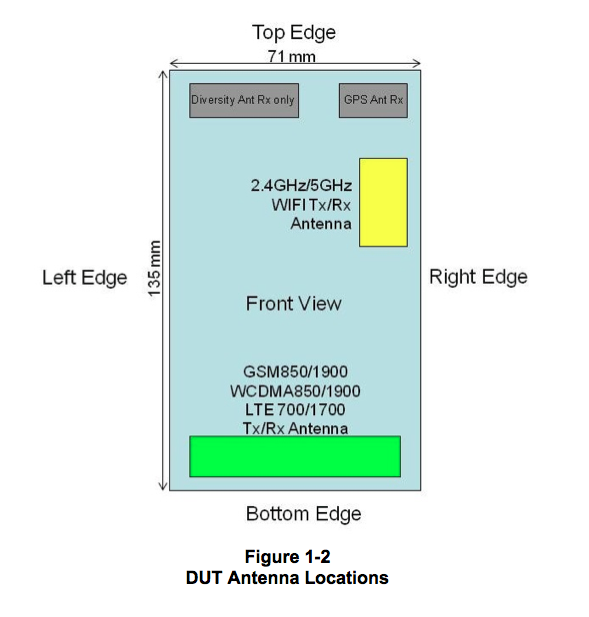
The T-Mobile SGS3 is unsurprisingly very similar to the AT&T SGS3, including support for both their own bands and AT&T’s bands for WCDMA as shown in the table below. The T-Mobile device of course supports WCDMA carrier aggregation, or DC-HSPA+. For those that aren’t familiar, DC-HSPA+ Category 24 (3GPP Rel.8) employes carrier aggregation in addition to the other HSPA+ features from Release 7. Essentially, two 5 MHz WCDMA carriers are aggregated together on the downlink, resulting in roughly double the performance of a single WCDMA carrier situation. Note that the uplink remains single carrier, so there’s even more of an asymmetry that happens, but given the traffic asymmetry that already exists for most mobile workloads this isn’t a huge deal.
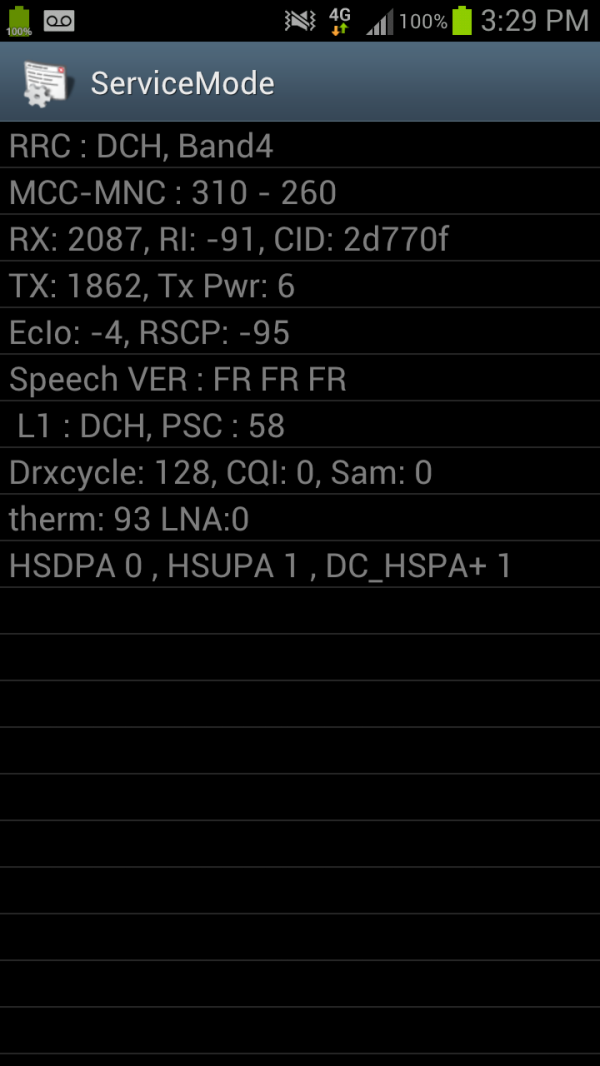
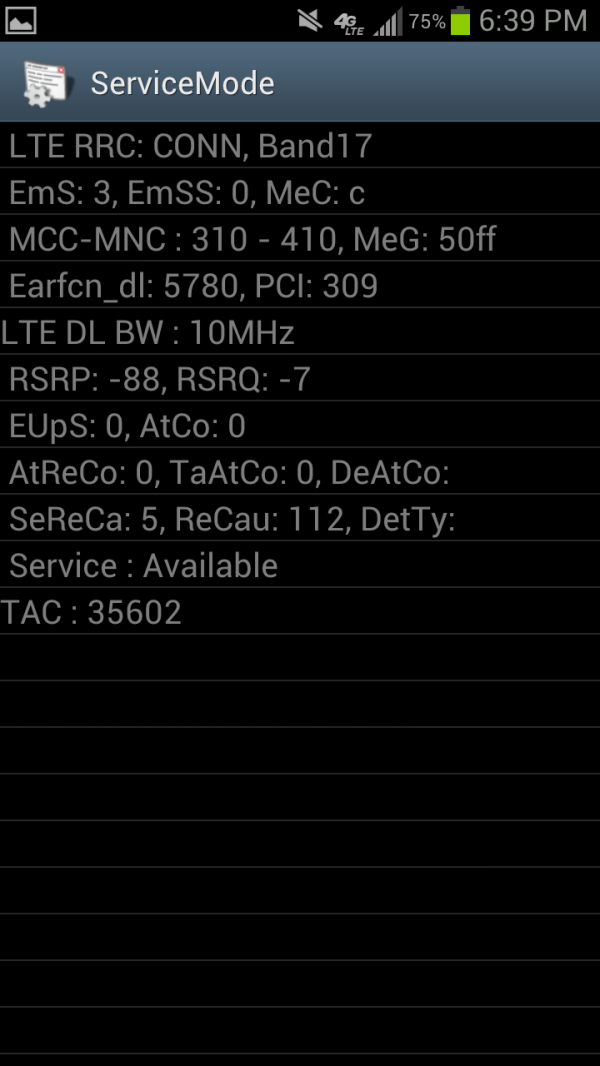
Samsung's excellent ServiceMode (*#0011#) is present on all the USA SGS3 variants, DC-HSPA+ shown on T-Mobile SGS 3 (left), 10 MHz FDD-LTE shown on AT&T Model (right)
Like the HTC One S, the T-Mobile SGS3 can be used on AT&T’s 3G network if you can manage to unlock one. This is a definite plus if you don’t care about LTE but do care about having a phone with a ton of WCDMA bands supported.
| SGS3 T-Mobile - Network Support | |||||
| GSM/EDGE Support | 850 / 900 / 1800 / 1900 MHz | ||||
| WCDMA Support | 850 / 1700 / 1900 / 2100 MHz | ||||
| HSPA Speeds | HSDPA 42.2 (Cat.24) / HSUPA 5.76 (Cat.6) | ||||
| Baseband Hardware | Qualcomm MSM8960 | ||||
Because of my limited time with the SGS3s, I haven’t had a chance to run a bunch of speedtests on AT&T LTE and report back with plots. In addition, because AT&T does not support DC-HSPA+ yet (and shows no indication of doing so), there’s not much to be learned from 3G WCDMA there, as it’s still just HSDPA 14.4 in my market and almost all others. I’ve still never seen a single AT&T market with 64QAM / HSDPA 21.1. I will update with AT&T LTE results when I have them.
I have however run a bunch on the T-Mobile in my home market of Tucson, AZ and compiled enough to generate some plots. To test, I used the same workflow as always, essentially running as many tests as possible using Ookla’s speedtest.net application on Android, exporting the results, and making some pretty graphs with python. I’ve rewritten my graphing code and prettied it up a bit as well with some stats.
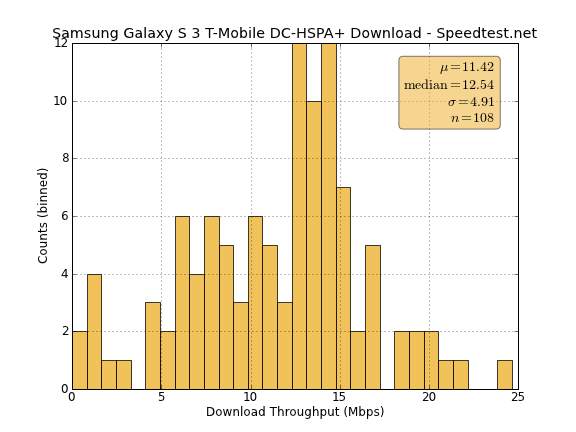
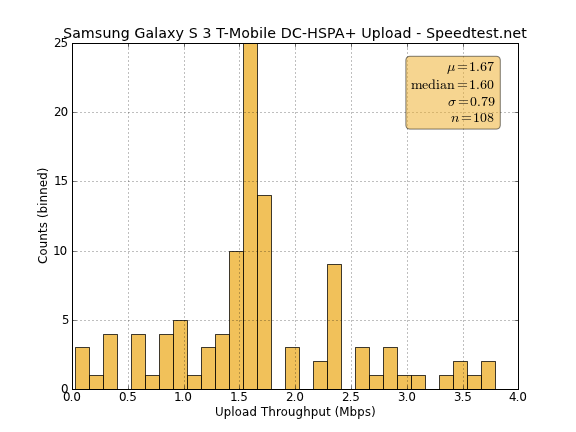
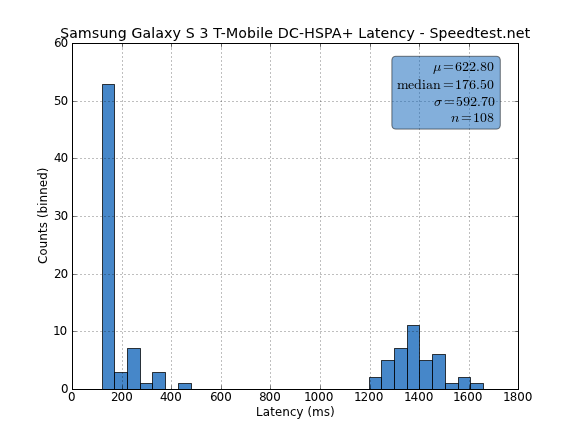
Unsurprisingly DC-HSPA+ is impressively fast on the downlink, with an average of around 11 Mbps and a maximum of just above 20 Mbps. It’s not the kind of performance you’ll get out of LTE (proving somewhat that using subcarriers through OFDMA and other enhancements does pay off), but it’s pretty darn impressive nonetheless. There’s a weird double distribution in latency probably due to setup time coming out of CELL_PCH and setting up the DC-HSPA+ link. Running a test right after this setup yields much lower latency thanks to T-Mobile’s flat IP network, which is why I say it seems to be connection setup related. I’m impressed with how fast T-Mobile’s DC-HSPA+ is in my area, and DC-HSPA+ isn’t a bad interim air interface until the carrier can deploy LTE. You have to applaud T-Mobile for being first to both deploy 64QAM on the downlink (HSDPA 21.1) and deploy DC-HSPA+, two things AT&T still has no intention of doing anytime soon.
I’m headed to an AT&T LTE enabled market as soon as possible to get some AT&T LTE results, but I don’t expect any surprises from that particular device.
WiFi
On the USA SGS3s, I was surprised to find that Samsung hasn’t gone with the on-SoC WLAN and instead implemented BCM4334, mirroring what was done in the international SGS3. BCM4334 we have talked about a lot before, it’s the 45nm version of BCM4330 with added support for 40 MHz channels on 5 GHz, among other lower power features and improvements. Of course, the SGS3s also include NFC (from the incredibly ubiquitous PN544) and BT 4.0 support (from BCM4334).
One of our readers pinged me and let me know that reliable iperf ports are now available on Android and iOS, so I’ll be switching over to using iperf for my main WiFi throughput testing instead of the 100 MB PDF hosted locally. What I’m looking at is still downstream throughput to the phone, since I wager that’s the direction people care most about. I tested a small number of the phones I’ve got on hand with iperf on the new Buffalo 802.11ac compatible router for comparison. For the purposes of the test I’ll be choosing the fastest WiFi interface possible for the device, eg 5 GHz when supported, 2.4 GHz when not supported.
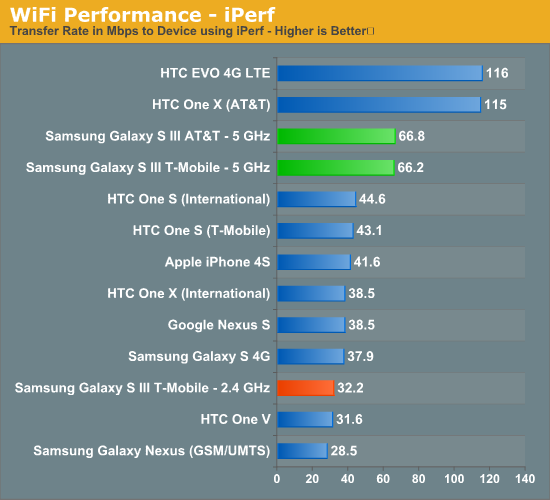
The SGS3s show a PHY of 150 Mbps on 5 GHz with 40 MHz channels, and 65 Mbps on 2.4 GHz with 20 MHz channels. Performance isn’t quite up to the MSM8960 devices like the EVO 4G LTE and One X. I suspect this is due to either limitations on the interface between the SoC and BCM4334, or possibly absence of some other MAC features. Either way I’m glad to see 5 GHz support advancing even more now, to the point where devices are starting to show up with 40 MHz onboard as well.
GNSS
The SGS3 includes onboard GNSS (Global Navigation Satellite System) configuration. In this case, that means GPS with GLONASS. I have no problems getting a fast lock even indoors or in an urban environment, and like other combos with GLONASS you can see those satellites pop into use when GPS signal is weak.
I’m unclear whether the USA SGS3s have gone with Broadcom’s BCM47511 GNSS like what was done in the international SGS3, or whether Samsung is using the MSM8960 onboard GNSS. I need to do more digging to be certain. I suspect this is done on MSM8960, however.
Speakerphone and Sound
Because I’m in the process of moving, I don’t have my sound testing setup complete, nor the sound meter for testing speakerphone. However, I will be able to get that data in the coming week and update with my findings.
Both the AT&T and T-mobile SGS3s use an Audience A2220 for noise rejection using those two microphones (at top and bottom) as well. I need to do my testing here but based on a number of calls I’ve placed already from both I suspect they’ll perform quite well.


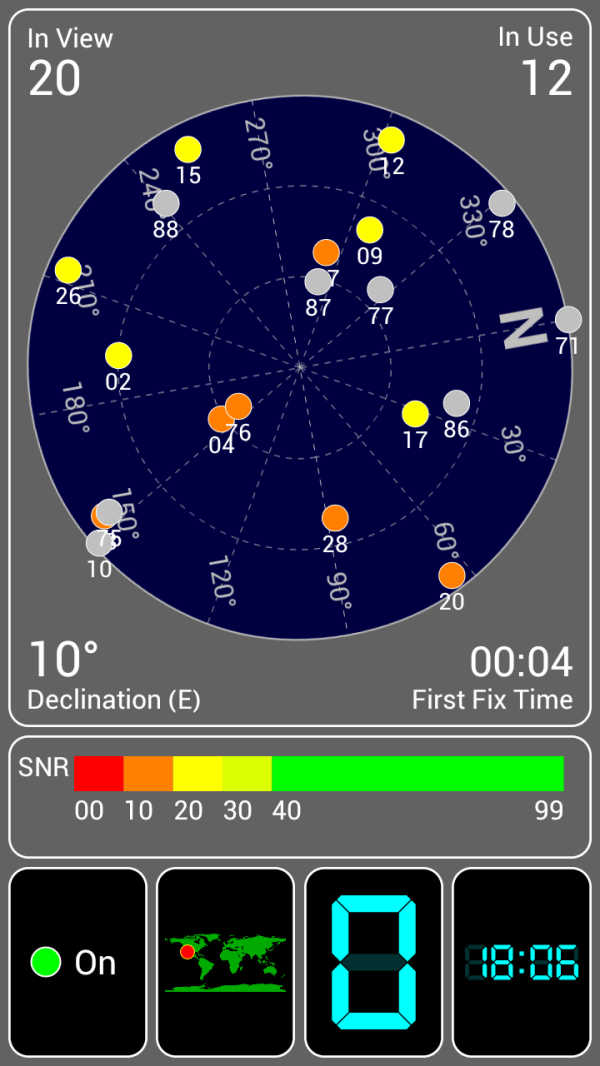
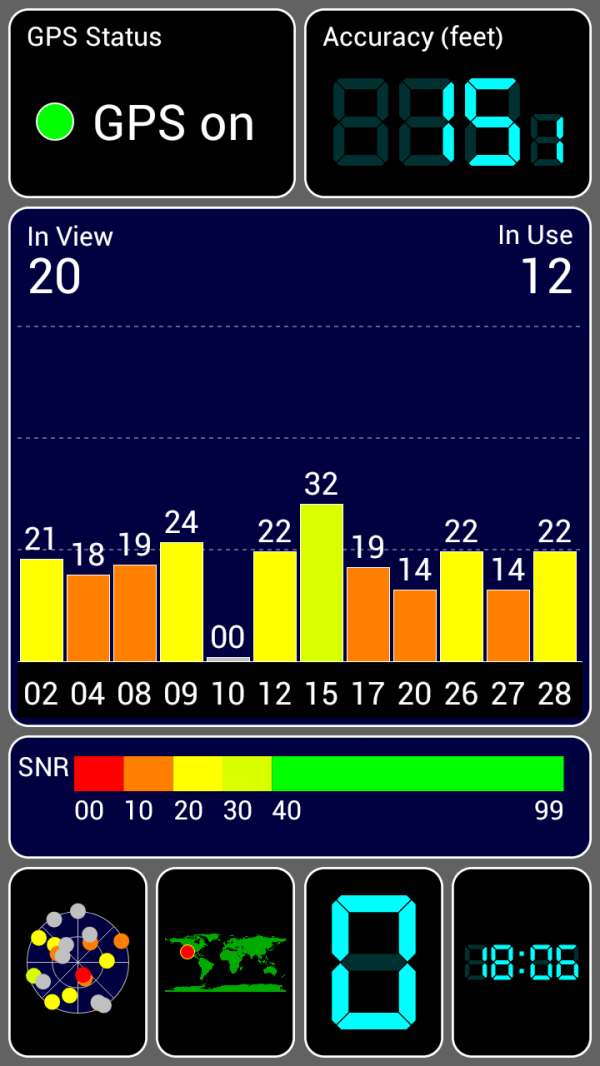








107 Comments
View All Comments
HexiumVII - Wednesday, June 20, 2012 - link
Darn no quad core love for the US?Impulses - Wednesday, June 20, 2012 - link
No big loss, the S4 is roughly equivalent despite being a dual, since it's an all new design instead of a core bump. The GPU is actually the bigger loss, if you're into graphically intensive games.B3an - Wednesday, June 20, 2012 - link
Exactly.The international quad-core version (which i have and love!) is based on ARM Cortex A9. While the US dual-core version uses the Krait SoC which is a lot closer to ARM's new Cortex A15 design (but it's not an A15, it's a custom design from Qualcomm thats similar in performance). So overall for CPU performance the international and US versions are pretty similar.
The international version definitely has a better GPU though - the higher clocked Mali-400 is the fastest GPU in any phone at the moment. Where as the US version has the slower Adreno 225.
On the other hand... the US version has 2GB RAM, where as the international has 1GB.
I guess Samsung felt bad about the slower GPU and tried to make up for it by giving you all 2GB instead.
Personally i prefer the international version because of the extra GPU performance as i do more gaming, and with a screen this big @ 720p gaming is great.
robinthakur - Friday, June 22, 2012 - link
So...quick question. I have an international version which I picked up in HK as well. What games actually make good use of the improved graphics? I've already got Angry Birds Space. I'm not that impressed with the device so far. The thin plastic back feels incredibly cheap for a device costing around £400 and the Android OS seems poorly optimised compared to the iPhone 4S I used to use, with much worse touch controls. The camera which initially sold me (along with the nice water drops animations on the Home screen!) with its rapid shots, also disappoints with pretty mediocre pictures compared to the 4S. Front facing camera is nicer though. The motion controls are utterly pointless as is face unlocking. Have you ever got the wave hand across the screen to take a screenshot to work? I've got it switched on but...nothing! There were plenty of options compared to iOS for to geek out over for 48 hours but now having to actually use the device it seems lacking, i dunno, just unpolished. Considering it just came out, why is text all fuzzy for example? Isn't this a retina display? I assumed that coming out more than 2 years after the iPhone 4, every phone has them these days, but apparently not. I'm considering selling it before the price drops and going back into the Apple Matrix as life seems easier with iOS all told.JamesL88 - Saturday, June 23, 2012 - link
"What games actually make good use of the improved graphics?"Well for starters newest Gameloft games such as the NOVA 3 tend to be very graphically demanding. Also True Android gamers love to buy emulators from black markets (or after markets if you prefer), such as Nintendo 64 emulator.
You're obviously iFan so I'm not going into discussion with strength and weaknesses of each OS, but I believe the GS3 uses the same Sony sensor used in iPhone 4s' camera. I seriously doubt that you even own GS3.
koyanishi - Tuesday, September 4, 2012 - link
I believe he does own a Galaxy S III.that's because he didn't figure out how to take the screen shot by swiping his hand across the screen.
The thing is, to do this your hand has to touch the screen. Your hand is in the form of a karate chop and you use the knife edge (sort to speak) to touch the screen and swipe across it.
I don't think he is that stupid for missing this because I after trying different ways of doing it never figured it out either but only learned of how to do it by reading tips on use of this phone in an android forum.
However on his other points of how the plastic feels cheap and lack of optimization (whatever that means) of the os in GS III I disagree.
bigboxes - Wednesday, June 20, 2012 - link
Am I wrong? The device doesn't look like it can stand up to much of anything. Better make sure you cover it from top to bottom with some kind of case.ATWindsor - Wednesday, June 20, 2012 - link
You probably are, plastics can be very solid and lightweight. The old Galaxy S2 is as far as one can tell much more solid than for instance the iphone.Impulses - Wednesday, June 20, 2012 - link
Samsung's designs may feel cheap at times but that doesn't necessarily translate to better impact survivability... Plastic weighs less and probably absorbs more force during impact... I've never owned a Samsung phone (I'm on my third EVO and my dumb phones were all Nokias & Sony) but I've seen plenty of them fly from my friend's hands. :p The glossy plastic they use probably does scuff easier than most materials tho. Then again, unlike reviewers who go thru phones like underwear, I think the majority of people end up it using cases anyway. I do it to protect my device's resale value as much a anything else.Belard - Wednesday, June 20, 2012 - link
What resale value?